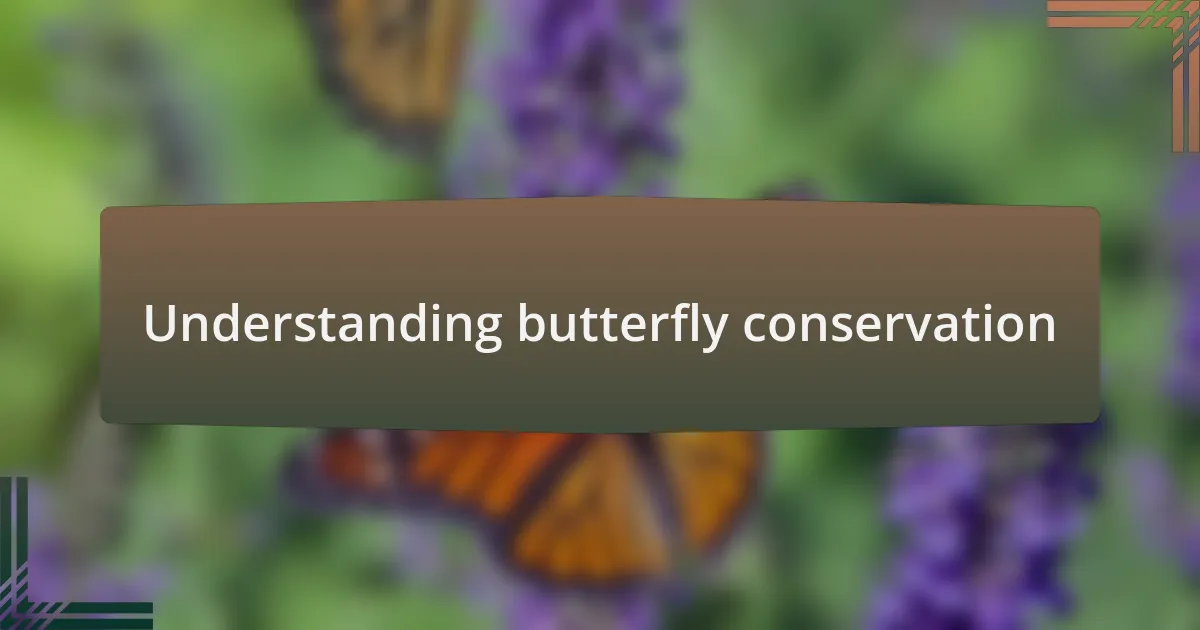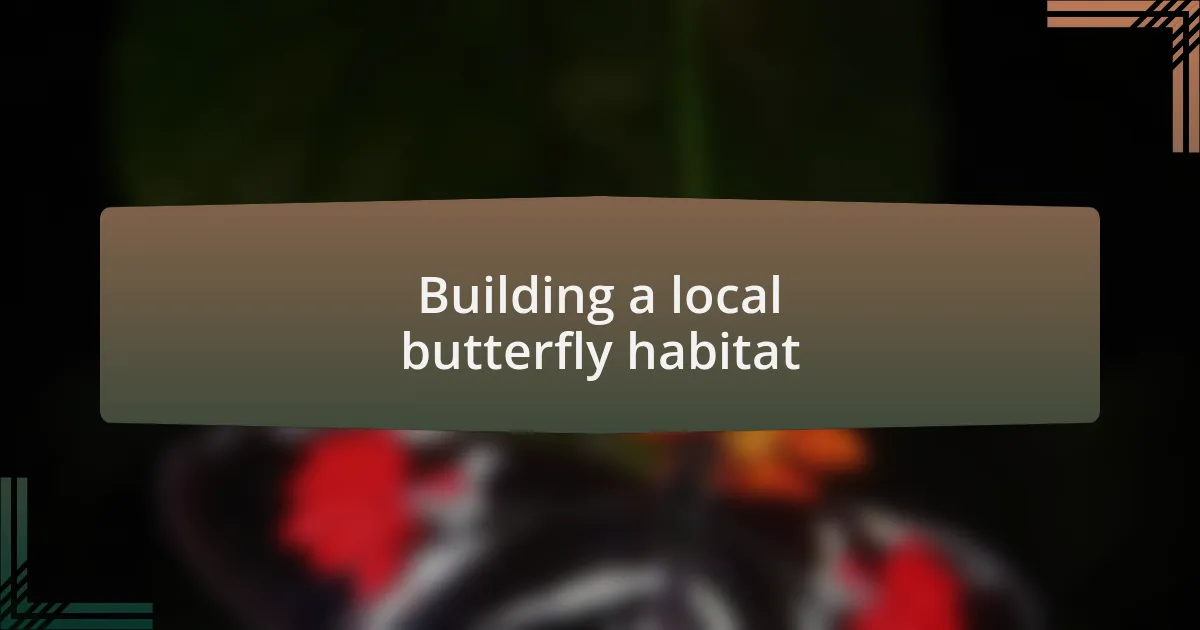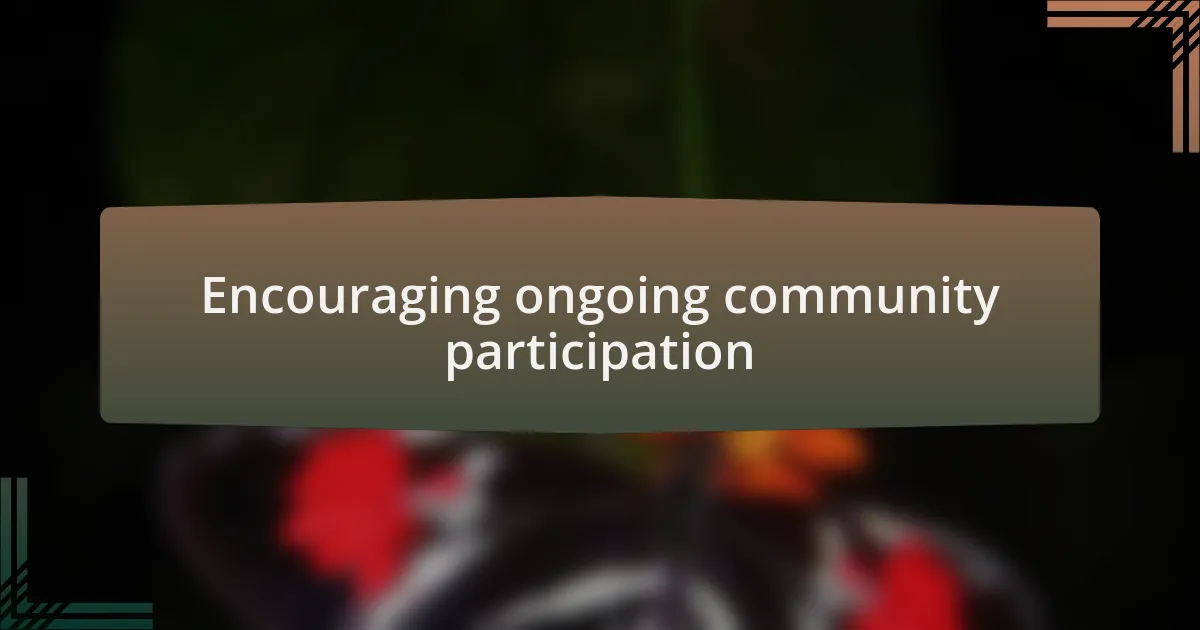Key takeaways:
- Butterfly conservation relies on community efforts, fostering bonds through shared activities like planting butterfly gardens and organizing events.
- Engaging schools in butterfly projects helps instill a sense of responsibility and appreciation for nature among students.
- Creating and maintaining butterfly habitats requires collaboration, knowledge sharing, and continuous community involvement.
- Personal experiences and storytelling enhance conservation efforts, building empathy and motivating individuals towards collective action.

Understanding butterfly conservation
Butterfly conservation involves protecting the habitats and ecosystems essential for their survival. I vividly remember the first time I observed a Monarch butterfly flitting among blooming milkweed. It struck me how dependent these beautiful creatures are on specific plants, raising questions about our role in preserving their habitats.
Understanding the challenges these insects face, such as habitat loss and climate change, is crucial. I once visited a local garden project aimed at creating butterfly-friendly spaces, and seeing the community come together to plant native flowers was inspiring. It made me realize that even in small efforts, we can create safe havens for these delicate beings to thrive.
Engaging with butterfly conservation means recognizing the interconnectedness of all living things. I often wonder what our world would look like without the soft flutter of wings gracing our gardens. The experience of seeing butterflies return to a restored habitat reminds me that we all have the power to make a significant impact, no matter how small our actions may seem.

Importance of community involvement
Community involvement plays a crucial role in butterfly conservation. I recall attending a local workshop where neighbors came together to learn about planting butterfly gardens. The excitement in the room was palpable as we shared our experiences and ideas. This collective enthusiasm not only strengthened our bonds but also emphasized the power of collaboration in creating environments conducive to butterfly populations.
When I participated in a community clean-up event, we were surprised by the number of habitats we discovered that needed attention. It struck me how our individual efforts combined could trigger significant change. I remember the joy on a child’s face when they spotted a butterfly for the first time, reminding me that community involvement can ignite a newfound passion for conservation, particularly among youth.
Moreover, involving the community fosters a sense of ownership and responsibility. I once helped organize a butterfly count, and watching everyone come together to contribute their findings was deeply rewarding. It raised the question: how often do we tap into our collective knowledge? Ultimately, this shared experience reinforces the idea that protecting these fragile creatures is not just a solitary task but a communal journey that we embark on together.

Building a local butterfly habitat
Creating a local butterfly habitat begins with choosing the right plants. I vividly remember my first visit to a local garden center, overwhelmed by the array of native flowers they offered. I soon learned that plants like milkweed and coneflower not only attract butterflies but also provide food for caterpillars. Have you ever felt that thrill of planting something and watching it flourish? There’s a unique joy that comes from nurturing a butterfly garden, knowing it serves as a haven for these delicate creatures.
As I collaborated with neighbors to design our community habitat, I was struck by how sharing ideas brought people together. We held weekend workshops, discussing the best ways to layout our gardens. I recall a moment when an elderly neighbor, recalling her childhood memories of butterflies, proposed an idea that truly transformed our vision: incorporating a small pond for water sources. It made me appreciate how, collectively, we draw from diverse experiences to create something greater than ourselves.
Maintenance is just as vital as creation. During our monthly meet-ups, I often found myself sharing tips on sustainable gardening practices. The satisfaction of seeing our garden thrive—and the butterflies returning—was palpable. It made me wonder: how can we keep this momentum going? Fostering continuous engagement ensures that the butterfly habitat not only survives but flourishes, creating a lasting impact on our local ecosystem and community spirit.

Engaging schools in butterfly projects
Engaging schools in butterfly projects can be a transformative experience for both students and the community. I remember the excitement in a local classroom when we introduced the idea of a butterfly garden. The students’ faces lit up as they discussed what plants to include, reflecting a sense of ownership that I found inspiring. Have you ever seen kids connect with nature? It’s fascinating how simply planting seeds can spark curiosity about ecosystems and biodiversity.
One memorable project involved a partnership with a nearby elementary school, where we designed an educational curriculum around butterfly life cycles. As we worked together to create lesson plans, I watched the teachers’ enthusiasm grow alongside the students’. The children crafted colorful journals to document their observations, making science tangible and personal. It made me realize that engaging young minds in conservation not only cultivates a sense of responsibility but instills a lifelong appreciation for our natural world.
Moreover, organizing field trips to our local butterfly habitat proved vital in solidifying that connection. I recall the moment young students spotted their first butterfly fluttering near our planted flowers; their laughter echoed in the air as they raced to catch a glimpse. This firsthand experience allowed them to see the fruits of their labor and understand the importance of their involvement. Engaging schools in these projects builds a bridge between education and conservation, ensuring that the next generation understands the critical role they play in protecting these fluttering wonders.

Organizing community conservation events
Organizing community conservation events is not just about bringing people together; it’s about cultivating a shared passion for butterflies. I recall a day when we hosted a community butterfly release. The joy on the faces of participants as they gently opened the envelopes to set the butterflies free was unforgettable. Have you ever experienced the rush of seeing a living creature take flight for the first time? That exhilarating moment bonded us all, reminding us of the beauty and fragility of life.
Planning these events requires attention to detail and the ability to rally local support. In one instance, we partnered with a local artist to create butterfly-themed decorations, which transformed our park into a vibrant space full of color and creativity. It was amazing to see volunteers of all ages come together, painting stations and hanging beautiful origami butterflies. The collaborative spirit made the event more than just a gathering; it became a celebration of community, art, and nature.
With every conservation event, I noticed that familiarity among participants grows deeper over time. I remember a conversation with a volunteer, who initially came to help with setup but ended up sharing her own butterfly stories and conservation ideas. This exchange not only enriched our event but also built lasting connections among attendees. Those interactions are essential—they highlight how meaningful community bonds can lead to ongoing support for butterfly conservation. Wouldn’t you agree that creating spaces for these dialogues can lead to more sustainable actions in the future?

Sharing personal experiences in conservation
Sharing personal experiences in conservation brings a unique depth to our efforts. I remember a small gathering we had where participants shared their first encounters with butterflies. One woman spoke of a transformative moment from her childhood—a memory of catching fireflies at dusk, feeling an inexplicable connection to nature. Listening to her story reminded us all of the reasons we were drawn to this cause in the first place. Isn’t it amazing how a simple story can reignite passion and purpose?
In another instance, I organized a storytelling circle during a butterfly monitoring session. As we sat in a circle with notebooks and cups of warm tea, one participant shared her experience of rescuing a chrysalis from a storm. Her animated recounting of the fragile creature’s struggle and eventual success in transforming into a butterfly resonated deeply within us. I could see tears of joy in the eyes of others, highlighting how our shared narratives create a tapestry of empathy and hope. Have you ever felt that power in your own conservation work?
What struck me most was how these heartfelt exchanges often moved beyond butterflies. I recall a moment when, during a particularly intense conservation planning session, someone brought up the issues of habitat loss not just for butterflies, but for many species. The conversation shifted to collective responsibility, and though it felt daunting, it also spurred us to brainstorm ideas for broader initiatives. Isn’t it invigorating how personal stories can motivate us towards actionable change, paving the way for deeper commitments to our environment?

Encouraging ongoing community participation
Encouraging ongoing community participation requires consistent engagement and a welcoming environment. I remember hosting a monthly nature walk where both seasoned enthusiasts and newcomers participated. As we roamed through colorful meadows, it amazed me how everyone shared their thoughts on butterfly behaviors and habitats. Each walk was not just about the butterflies; it became a space for building friendships and fostering a sense of belonging. Have you ever seen how community bonds can blossom over a shared love for nature?
Another method that has proven effective is inviting community members to contribute to our projects. I once organized a local art contest where participants depicted their favorite butterflies. The submissions were not only beautiful but sparked conversations about the butterflies we all hoped to protect. It was inspiring to see how creativity could pull people in, leading to a team of art lovers who were eager to volunteer for conservation efforts. How powerful is it when art connects hearts and minds toward a common purpose?
To keep the momentum going, I’ve learned the importance of celebrating milestones together. When we reached a goal in our conservation project, I suggested throwing a small celebration. Watching everyone’s faces light up with pride reminded me that acknowledging progress nurtures ongoing commitment. It’s moments like these that reinforce the idea: When we celebrate our successes, we not only uplift our spirits but also deepen our ties within the community. Isn’t it refreshing to reflect on how collective achievements can foster a more vibrant, active group?